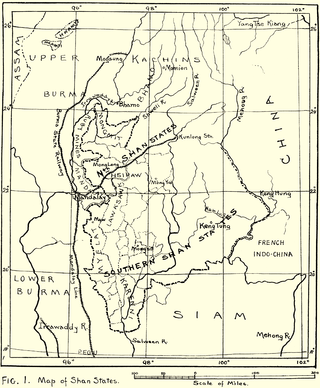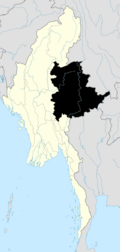
Shan State is a state of Myanmar. Shan State borders China (Yunnan) to the north, Laos to the east, and Thailand to the south, and five administrative divisions of Myanmar in the west. The largest of the 14 administrative divisions by land area, Shan State covers 155,800 km2, almost a quarter of the total area of Myanmar. The state gets its name from Burmese name for the Tai peoples: "Shan people". The Tai (Shan) constitute the majority among several ethnic groups that inhabit the area. Shanland is largely rural, with only three cities of significant size: Lashio, Kengtung, and the capital, Taunggyi. Taunggyi is 150.7 km northeast of the nation's capital Naypyitaw.
Lawksawk, also known as Yatsauk, is a town in Shan State, Myanmar. It is the capital town and administrative center of Lawksawk Township. The town is located along an oxbow lake of the Zawgyi River at an altitude of 910 metres (2,990 ft). Lawksawk is about 48 kilometres (30 mi) north of Taunggyi, or 70 kilometres (43 mi) by road on National Route 43. It was the historical capital of Lawksawk State. The town is near Bahtoo Station, a major military base.

Laihka State, also spelt Legya or Lecha, was a state in the central division of the Southern Shan States of Burma, with an area of 3,711 square kilometres (1,433 sq mi).

Taunggyi District is a district of Shan State in Burma. The principal town and administrative center is Taunggyi. This district has 12 towns and 3001 villages.

Kengcheng or Keng Cheng was one of the Shan states. In 1896, part of Keng Cheng was incorporated into the neighbouring state of Kengtung in what is today Burma, and the other part, which is now in Laos, went to French Indochina.

Kenghkam or Keng Hkam was a Shan state in what is today Burma. The capital was the town of Keng Hkam, located by the Nam Pang River.
Mawnang was a small Shan state in the Myelat region of what is today Burma. Its population was mostly Taungyo.

Hsipaw, also known as Thibaw, is the principal town of Hsipaw Township in Shan State, Myanmar on the banks of the Duthawadi River. It is 200 kilometres (120 mi) north-east of Mandalay.

The Burmese Resistance Movement of 1885–1895 occurred almost immediately after the fall of Mandalay. Due to the rapidity of British advancement up the Irrawaddy River, the bulk of the Burmese army suffered few casualties. Many had not experienced actual fighting. Nevertheless, the issue of the Hluttaw’s order to surrender on 27 November 1885 meant that Burmese garrisons south of Mandalay had to disarm without putting up a fight. Soon widespread resistance started to break out in Upper Burma, Lower Burma, the Shan Hills, Kachin Hills and Chin Hills which did not die out until 1896.
"To all town and village thugyis, heads of cavalry, heads of the daings, shield bearers, heads of jails, heads of gold and silver revenues, mine workers, settlement officers, heads of forests, and to all royal subjects and inhabitants of the Royal Empire: Those heretics, the English kala barbarians, having most harshly made demands calculated to bring about the impairment and destruction of our religion, the violation of our national traditions and customs, and the degradation of our race, are making a show and preparation as if about to wage war with our State ... The local officials shall not forcibly impress into service anyone who may not wish to serve. To uphold the religion, to uphold the national honour, to uphold the country's interests, will bring about threefold good; good of our religion, good of our master, and good of ourselves; and will gain for us the important result of placing us in the path to the celestial regions and to Nibban. Whoever, therefore, is willing to join and serve zealously will be assisted by His Majesty with royal rewards and royal money, and be made to serve in the capacity for which he may be fit. Loyal officials are to make inquiries for volunteers and others who may wish to serve, and are to submit lists of them to their respective Governments."

Hsipaw, also known as Thibaw, was a Shan state in what is today Myanmar. Its capital was Hsipaw town. Hsipaw State was perhaps one of the most well known and powerful Shan States.

Mongmit or Möngmit, also known as Momeik, was a Shan state in the Northern Shan States in what is today Burma. The capital was Mongmit town. The state included the townships of Mongmit and Kodaung.

South Hsenwi was a Shan state in the Northern Shan States in what is today Burma. The capital was Mongyai town which had a population of about 2000 in the 19th century.

Mawkmai, also known as Maukme, was a Shan State in what is today Burma. It belonged to the Eastern Division of the Southern Shan States.

Mongnai, also known as Möngnai, Mone, Mōng Nai or Monē, was a Shan state in what is today Burma. It belonged to the Eastern Division of the Southern Shan States. Its capital was Mongnai town.

Lawksawk, also known as Yatsawk was a Shan state in what is today Burma. It was located north of Myelat and belonged to the Central Division of the Southern Shan States. Its capital was Lawksawk town. The state included 397 villages and the population was mostly Shan, but there were also Danu, Pa-O and Palaung people in the area.

Mongpai, also known as Mobye, was a Shan state in what is today Burma. It belonged to the Central Division of the Southern Shan States. Mongpai was based in the modern town of Mobye.
Kyawkku (Myinkyado) is a town in Shan State, Myanmar. It is part of Lawksawk Township of Taunggyi District.

Princess Sao Sanda is the last princess of Yawnghwe, a now disestablished Shan state in present-day Myanmar. She is the eldest daughter of the last Saopha of Yawnghwe Sao Shwe Thaik by his consort Sao Nang Sanda. A journalist at Reuters, she coauthored several books with her husband Peter Simms. Her 2008 book The Moon Princess: Memories of the Shan States chronicles a turbulent period in Burma's history, providing both her life story and a chronicle of her father, the first president of the Union of Burma after its independence.













